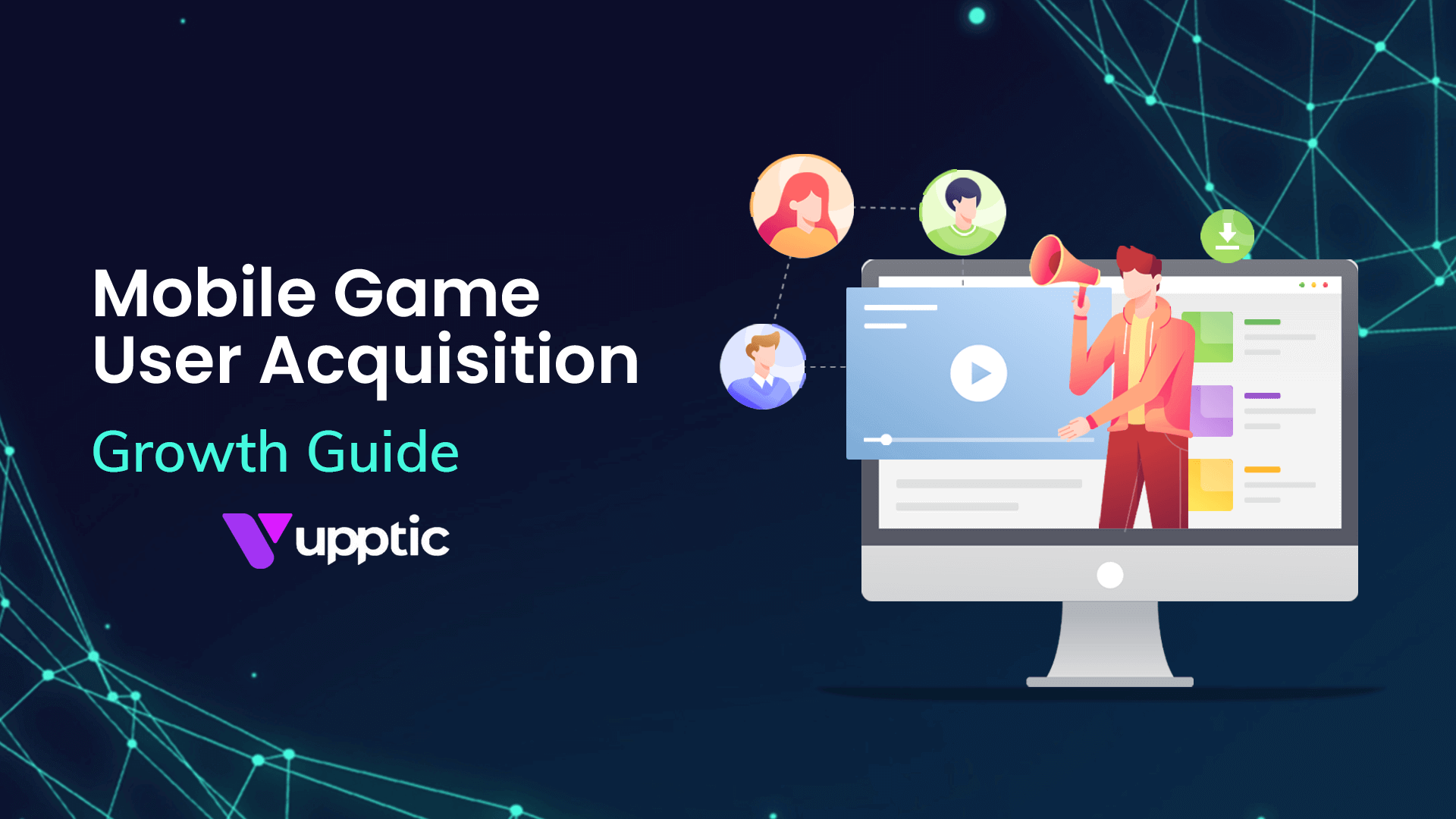These days, the mobile games market is more competitive than ever. After experiencing its first contraction ever in 2022, the mobile games market has more companies fighting for less money and possibly even fewer players. That makes effective mobile game user acquisition paramount.
This article will cover mobile game user acquisition from high-level concepts (such as “What is mobile game user acquisition?”) to practical insights (“How do you avoid ad fraud?”) and much in between. Get versed in all the latest below.
Navigate to Section
- What is mobile game user acquisition?
- The purpose and importance of a user acquisition strategy
- Types of user acquisition for mobile games
- Know your user acquisition KPIs
- Crafting your mobile game user acquisition strategy
- Identify your target audience
- Scope out the competition
- Include app store optimization
- Don’t forget search engine optimization
- Choose the right channels
- Make use of content marketing
- Combine paid and organic acquisition
- Use automation whenever possible
- Focus on making great creatives
- Cross-promote your mobile game
- Multi-platform and cross-platform games
- Take advantage of current trends
- Analyze and optimize with a marketing stack
- Crafting your mobile game user acquisition strategy
What is mobile game user acquisition?
User acquisition is the process of using marketing campaigns and organic growth initiatives in order to gain new customers, users or players. In mobile games, specifically, this means identifying buckets of new prospective players across platforms, games and social channels and targeting them with a resonant creative messaging to drive them into your game.
User acquisition is a cross-functional discipline which requires a diverse set of skills to perform effectively namely, creative development and production, marketing operation and channel management, analytics and data science, and negotiation and relationship management.
Mobile games user acquisition has historically relied on the abundance of data to target and acquire users. However, as privacy concerns grow, the largest platforms that game developers have relied on to supply this data, such as Apple, Google, and Facebook, are beginning to restrict access.
As a result of less data granularity, game developers and marketers are having to innovate in their user acquisition strategies and employ more innovative modeling to understand UA performance. Nonetheless, there are still many best practices for mobile games user acquisition that have been cultivated over the years to drive large scale differentiated growth for successful developers and publishers.
Terms you should know
Impressions
Impressions are how many times an ad or creative is seen by people. Fun fact: The click-through rate (CTR) is the percentage of people who have clicked on your ad. It can be found with a simple formula: clicks ÷ impressions = CTR
Attribution
Attribution is the process of assigning value to actions users take that lead to a conversion / install (typically, this is, in part, to properly credit and pay those who helped contribute to the install – such as ad inventory suppliers).
App Store Optimization (ASO)
ASO is a tactic for increasing your app’s visibility in app stores – typically for the purpose of driving more installs. ASO incorporates keyword research, A/B testing, creative iteration, and various other methods for increasing visibility.
Search Engine Optimization (SEO)
SEO is a tactic for increasing your app’s (or website’s) visibility in search engine results – also typically with the purpose of driving more installs. SEO incorporates keyword research and knowledge of search engine algorithms for increasing visibility.
Organic app installs
Organic app installs are app installs that come through “organic” marketing initiatives (i.e. non-paid advertising) – such as content marketing or social media marketing. Installs driven by ASO and SEO would also typically be considered organic app installs.
Churn
Churn is the term for customers who uninstall your app after a specified time period. Your churn rate can help you understand how “sticky” your app is. Your churn rate can be calculated with this simple formula: (lost customers ÷ total customers at start of time period) x 100 = churn rate
The purpose and importance of a user acquisition strategy
Some may question why a user acquisition strategy or marketing campaigns are needed. Can’t you just plug and play ads these days? Won’t the game sell itself? The short answer to those questions is: “Yes.” The longer answer is: “Yes… but you won’t get very far.”
Even if you have a great game, you won’t be successful if no one sees it or it reaches an incompatible audience. And, sure, you can plug and play ads so your game is seen by more people – but in an industry that is saturated with competition, if you aren’t following best practices and innovating regularly, you’re likely to run unprofitable ads – wasting your time and money.
Driving profitable growth is the real purpose of a mobile games user acquisition strategy. It’s not just about making sure your game is seen and played, but also that you’re achieving maximum return on your marketing investments.
Types of user acquisition for mobile games
There are a few key types of user acquisition when it comes to mobile gaming. While all are required to have a successful mobile game, they are also distinct enough to require their own strategies, tools, and know-how.
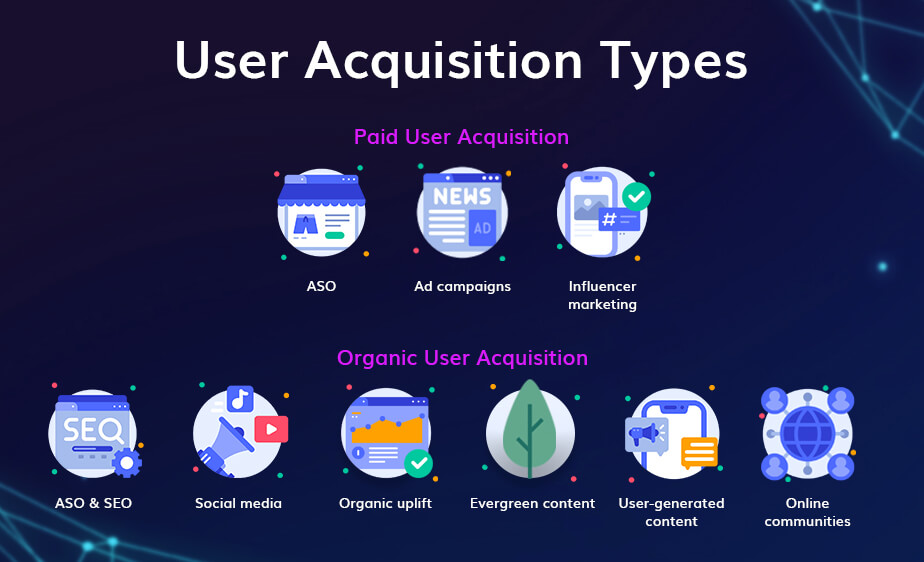
Paid user acquisition
Paid user acquisition is the practice of running effective ad campaigns. While ad campaigns are integral to any user acquisition effort or marketing initiative, they’ve become more difficult to spend effectively on in the last few years due to changes in privacy laws (GDPR, CCPA, CPRA, etc.) and privacy rules from major providers like Apple and Google.
Influencer marketing can also be considered a form of paid UA.
Learn more about specific challenges with paid user acquisition below:
Organic user acquisition
Organic user acquisition refers to all “unpaid” outreach – “unpaid” meaning you aren’t directly paying a provider for ad space. Organic user acquisition does still cost money in the form of social media managers and content marketing but overall, it’s less costly than paid UA campaigns are, so it’s a vital part of any user acquisition effort.
Additionally, with paid UA campaigns, there is a certain amount of organic uplift – or users who come across the game organically due to the effects of paid advertising. An example of this is an ad campaign that drives up downloads and gets a game into the Top 10 of an app store downloads list, where a potential player then sees the game and downloads it themselves.
Organic channels also play an important role in retention – which is vital to sustainable growth – as they allow your audience to communicate directly with you and allow you to engage in meaningful ways with your audience.
Learn more about organic content below:
Search and App Store Optimization
App store optimization focuses on a game’s app store product page and rankings while search engine optimization focuses on where and how your website shows up in search results. Both are vital to be found organically by new users.
Learn more about app stores and search engines below:
Know your user acquisition KPIs
Key performance indicators, or KPIs, are ways to measure the effectiveness of your user acquisition efforts. They are important for ensuring you’re not overspending for the ads you’re running or the users you’re acquiring.
Budget
A budget is one of the most basic KPIs. It’s simply the amount of money you’ve set aside to run a campaign over a specific timeline. Every campaign should have a budget and predefined scope so you aren’t simply running ads indefinitely and burning through your company’s money.
Conversion rate (CVR)
Your conversion rate is the percentage of people who see your ad and subsequently download your app. CVR can be calculated with the following formula: (conversions ÷ impressions) x 100 = CVR
Customer acquisition cost (CAC)
CAC is essentially how much money it costs to acquire a user. CAC can be calculated with the following formula: total marketing costs ÷ total new customers = CAC
Return on ad spend (ROAS)
Return on ad spend (ROAS) is the rate at which you generate revenue from an ad campaign. For instance, if you spend $100,000 on an ad campaign and get 10,000 users who spend on average $12 each on in-app purchases, then you’ve generated $120,000 from the campaign which is a ROAS of 120%.
What specifically is the ROAS (return on ad spend) formula?
The equation for ROAS is simple: (user generated revenue over a specific timeframe) ÷ (ad spend over the same timeframe)
Most marketers target a ROAS of at least 100% meaning you’ve recouped your entire campaign budget and any additional revenue will up profit. UA campaigns which consistently perform under 100% need to be seriously evaluated for efficacy and either optimized or cut.
Average revenue per user (ARPU)
ARPU measures how much revenue the average user generates – though it typically is used to measure short-term goals, as opposed to a user’s entire lifetime revenue. ARPU can be found with the following formula: total revenue ÷ total users = ARPU
Lifetime value (LTV)
LTV is also used to gauge how much revenue a user generates – however, it covers the course of their lifetime in your app through in-app purchases or ad revenue. It’s an important KPI to keep an eye on, because you always want it to be higher than what it costs to acquire a user. High quality users greatly lift LTV.
There are multiple formulas for finding LTV, but one of the most simple is: average revenue per user per day x average number of days user is retained = LTV
Payback window
A payback window is the amount of time it takes for marketing spend to be recovered from a user acquisition campaign. Payback windows vary wildly by business objectives but span from 30, 60 or 90 on the low end, to 180 or 365-day or even multi-year payback at the high end.
A typical model for payback window analysis is to measure your cohorts by a Dx ROAS percentage. If you have a D90 payback target, that is the point at which your cohorts need to be hitting 100% ROAS.
In order to make sure your cohorts are on this trajectory, it’s important to measure your cohort maturation against early ROAS targets which map to a cohort maturation curve which will will derive 100% ROAS by your payback window.
Historically, game growth marketers have had granular channel and user level data which enabled companies to accurately and cleanly measure revenue and cost and operate with a high confidence that their ad spend was backing out profitability within their payback windows.
With the loss of granular IDFA data due to ATT, there is much more ambiguity regarding the value of specific player cohorts across some marketing channels. This has caused many advertisers to become more conservative with their payback projections, shortening their payback periods.
Media billing models
In addition to general KPIs for measuring marketing performance, there are specific KPIs associated with top-of-funnel ads serving and measurement. Understanding these KPIs are critical to understanding your game’s marketing funnel performance.
Cost per click (CPC)
CPC is one of the most common media buying models. In CPC, an advertiser pays a vendor, such as a game developer or advertising networks, for every click on their ads. These are especially common for UA campaigns where the goal is to drive traffic to a certain digital property. The formula for CPC is: ad cost ÷ ad clicks = CPC
Cost per mille (CPM)
CPM is another very common media buying model. In CPM user acquisition campaigns, the advertiser pays for every 1,000 impressions or ad views (mille being Latin for 1,000). These are great for when you want to raise awareness but don’t necessarily need to drive traffic anywhere. The formula for CPM is: (ad spend÷ impressions) x 1,000 = CPM
Installs per mille (IPM)
IPM is often a better way to measure an ad’s effectiveness than CPM or CPC – as they are based on installs, instead of simple ad views or clicks (which are not always intentional). The formula for IPM is: (installs x 1000) ÷ impressions = IPM
Cost per install (CPI)
In CPI user acquisition campaigns, advertisers pay for every install that can be attributed to an ad placement. This can be great for increasing your install rate, but the quality of installs can vary from vendor to vendor and cost associated with CPI user acquisition campaigns are generally high. CPI campaigns are best coupled with specific granular targeting.
The formula to find your CPI is: campaign spend ÷ installs = CPI
Crafting your mobile game user acquisition strategy
Now that you have a basic understanding of mobile games user acquisition and the components that make it up, you can start crafting a holistic strategy for your games. Let’s go step-by-step through the process of creating a user acquisition strategy for your mobile game.
Identify your target audience
There are two approaches to creating a product-market fit for a game. One is to build the game you have in mind and then find an audience that fits it. The other is to find an underrepresented audience and build a game that caters to them.
In such a hyper-saturated industry, it never hurts to think about and identify your audience before you even start creating a game. Catering to niches with less competition is a growing recipe for success for many game developers.
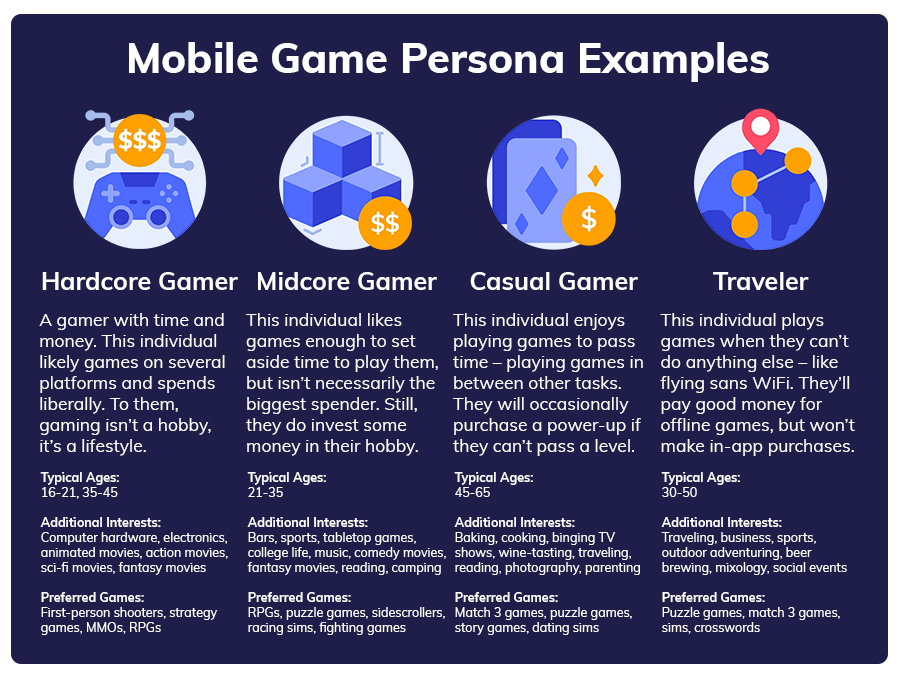
This is important for deciding where you will ultimately place ads, what social media platforms you’ll build a presence on, and what mechanics and narratives your game will have.
If you track data on your players you can analyze the information to find key insights for building player personas. Otherwise, using surveys and engaging with your audience on social media platforms can yield similar insights.
Don’t forget to test different demographics as well. Even if you’ve identified your main audience, you may be surprised at the traction you get in different age groups, geos, genders, etc. Small-scale ad campaigns targeting different groups can yield surprising results.
- Tools for the job: Your in-game analytics platform, app store analytics, Facebook data and analytics, Google Trends, Google alerts for mentions of your game.
Scope out the competition
Getting a feel for the competition goes hand-in-hand with identifying your target audience and creating a game. If you find out the competition for the game genre you’re thinking of going with is stiff, for instance, you might want to try out a genre with less competition.
Additionally, much like with your target audience, keeping tabs on the competition should be a continual part of your user acquisition strategy. Identify what they don’t do well and use it to your advantage. See what their own players are pining for and provide it before they can. Check out their ads to see how compelling they are.
You can also make use of platforms that supply industry intelligence data to see how your competitors are performing and where they are seeing the most success. This can be used to either mimic their behavior or avoid where they are in favor of less-used platforms.
- Tools for the job: Apptopia, AppMagic, Data.ai, Sensor Tower, Similarweb, Google Trends, Google alerts for mentions of competitors and their games.
Include app store optimization
App store optimization (ASO) is critical for anyone making mobile apps. If no one can find your app in an app store, it won’t be downloaded or played – which means zero revenue.
Discoverability and conversion
ASO can be broken down into two focuses: discoverability and conversion. Both are important for successful ASO.
Discoverability optimization
Discoverability focuses on the things you need to do in order for people to see your app to begin with – this includes A/B testing different icons, subtitles, categories, and keywords. It also focuses on keeping app ratings high. These all impact where and how your app shows up in search results, top charts, and promotional or featured sections of an app store.
Conversion testing
Conversion testing focuses on the things you need to do in order for people who have already seen your app to take the leap and download it. Similar to discoverability optimization, it also focuses on A/B testing icons, keywords, and the like. But there is also a strong focus on testing out different preview videos, screenshots, and descriptions.
Key app store components
An app store has a lot of moving parts. It’s important to understand what all these parts are to ensure you’re making the best decisions possible when it comes to your ASO strategies.
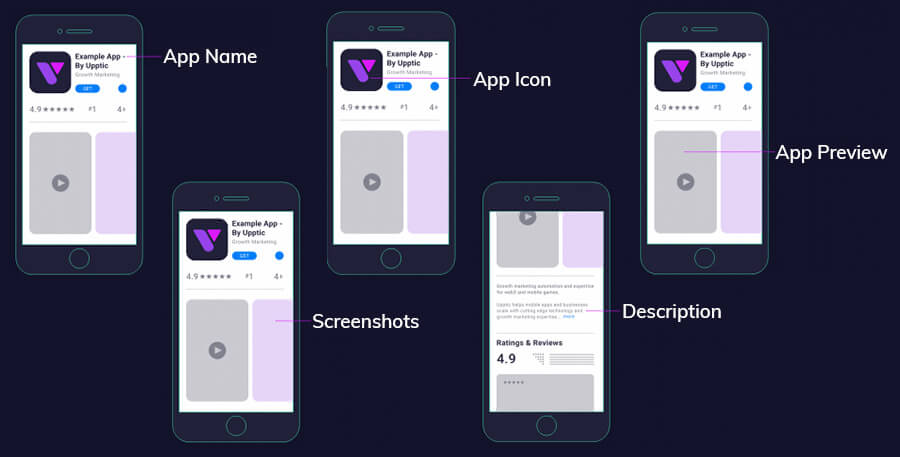
Product landing page
The product landing page for a mobile game contains everything a user needs to know about the game itself and is where people can download the game.
It prominently displays the game title and game icon, provides a synopsis of the game, lists the mobile game developer and/or publisher, shows the aggregate rating of the game, includes game reviews, and often shows data such as how many downloads the game has and how large the game is.
The product landing page contains the following important elements for A/B testing or iteration: App Title, Subtitle, App Icon, App Previews, Screenshots, App Description, Promotional Text, Ratings & Reviews, Keywords, In-App Purchases & Subscriptions, What’s New, Categories, and Localization.
Storefront
The storefront, or front page, is where users land when opening an app store directly. Each app store is a little different, but it typically includes featured apps, a search bar, and quick access to top charts, app discounts, and category pages.
Featured apps may be hand-picked by an app store’s editors or algorithmically generated by the app store based on the user’s interests. In either case, they typically only feature apps with high user ratings and a fair volume of downloads and revenue.
Top charts
Top charts highlight the most popular apps. They are typically broken down by most downloaded and top grossing. Often they can be segmented by free or paid apps and by app category as well. In order to appear here, you typically need to have a significant amount of downloads and revenue behind your mobile game.
“Breakout” apps – new apps seeing quick and strong growth – may also be featured in this area. This allows new apps that don’t have the download or revenue volume to appear in top charts to be featured prominently.
Category pages
Category pages provide category-specific top charts and featured apps, allowing people to dig deeper into a specific area they are interested in than they could from the top charts or storefront alone.
Gaming apps are typically broken down into the following categories: Action, Adventure, Arcade, Board, Card, Casino, Casual, Family, Educational, Music, Puzzle, Racing, Role Playing, Simulation, Sports, Strategy, Trivia, and Word.
Discounts page
Many app stores feature a section dedicated to app discounts and sales. It’s a great place to find a great app at a bargain price. To appear in this section, you must be running a deal on your mobile game.
Search bar
The search bar is typically accessible anywhere in the app store. It’s also the main go-to for finding an app through an app store search. Over 60% of app downloads come via the search result in app stores. Because of this, an Apple search ad or Google ad can be very effective.
Key KPIs and metrics for ASO
ASO has its own subset of KPIs to watch to ensure that the changes you’re making are effective to your larger user acquisition goals. Here are a look at several of the most important app store optimization KPIs – and how they’re affected.
Downloads and installs (CR)
The most basic metric to watch is how your ASO impacts downloads and installs of your mobile game. This is also one of the main metrics typically used for ranking in the stores top charts (the others being gross revenue and user ratings). This metric also factors into your conversion rate (CR).
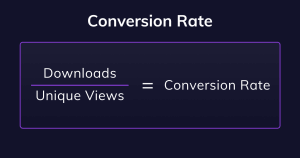
Gross revenue (ARPU, LTV)
Gross revenue is another basic metric of success for your mobile game – and also impacts the ranking of your mobile game in app store charts. It’s also a component of figuring out KPIs such as Average Revenue Per User (ARPU) and Lifetime Value (LTV).
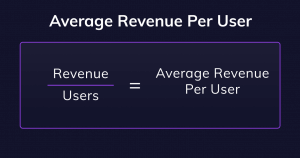
User ratings and reviews (CR)
User ratings impact how your mobile game shows up in search results and top charts, so it’s important to humbly read user reviews, implement feedback when necessary, and respond to complaints. Because ratings and reviews are a window into your app for newcomers, they impact conversion rate (CR).
Keyword, category, chart rankings (CR)
Keywords, categories, and top charts all go hand-in-hand. The categories you select for your mobile game will dictate what charts and sections it shows up under in the app store. Every keyword will dictate when and where your app is found in search results. You always want to optimize for low competition and high volume – which affects your conversion rate (CR).
Icon, name, subtitle (CTR)
Ranking high in keywords, categories, and top charts is only half the battle. The other half of the battle is getting people to click on your app when they see it. This is measured by the clickthrough rate (CTR), which is impacted most by your icon, mobile game name, and subtitle.
- Tools for the job: Many app stores have built-in tools and analytics you can use to get a basic lay of the land. Mobile game growth agencies like Upptic also offer in-depth app store optimization services to ensure you’re getting the best ROI on your ASO initiatives.
- Check out our full-length ASO guide.
Don’t forget search engine optimization
Aside from app store optimization, search engine optimization (SEO) is the other critical component for the organic discovery of your mobile games. Search engine optimization is the process of iterating on your website to make sure its pages are appearing higher in search results on Google and other search engines.
Style and substance
The first priority should be to update your website so that it’s keeping in line with the latest search engine optimization practices. This means having metadata filled out comprehensively and correctly, having feature images for every page, and making sure they’re hitting on relevant keywords. For instance, a page focused on your latest hypercasual game should rank highly for keywords like “hypercasual games”.
The role of organic content
Once your main pages are updated and in good working order, the next step is to build out a plan for evergreen content. Do you ever wonder why every company seems to have a blog these days? It’s because they provide an easy way to keep making evergreen content that will allow them to continue ranking in keywords that are important to them. Evergreen content is critical for good SEO.
Keywords research
There are several tools to help you decide which search terms, or keywords, you should be focusing on for your search engine optimization. Firstly, you should find out what keywords people are already using to find you by connecting your website to something like Google Search Console.
Remember when we talked about competitor research above? What search terms did you use to learn who your competitors are and what they are doing? Those could also be great keywords to pursue so you’re showing up as an alternative alongside your competitors.
Ultimately though, you’ll want to use tools that allow you to see how many people use a search term in a given month vs. how many companies are ranking for those search terms. The best strategy is to optimize for high volume, low competition search terms.
Once you know the keywords you want to use, you can use additional SEO tools to help you create content that will rank for those keywords.
- Tools for the job: Tools like Google Search Console can assist you in finding out how people are discovering your website. Tools like Moz can help you discover high-ranking keywords. Tools like MarketMuse can help you craft content that ranks highly for specific keywords.
Choose the right channels
When it comes to choosing the right channels to engage with your audience, there is an abundance of choices, but they can largely be broken down into organic channels and paid channels – though there is some overlap between the two.
Paid channels
Paid channels come in a few different flavors. There are your everyday ad platforms, social media ad platforms, and CTV/OTT ad platforms.

Social media ad platforms
Social media ad platforms are ad platforms run by individual social media companies. These include Meta for Business (for Facebook and Instagram ads), LinkedIn Ads, Twitter Ads, TikTok Ads, and more. Since these platforms typically have the most data about their users, they’re the best for segmentation and targeting.
Ad networks and rewarded video platforms
The largest ad platforms allow you to find ad space across the web or mobile spaces through ad networks. Major ad platforms with ad networks include Unity, Digital Turbine / AdColony, AdMob,and AppLovin. These are great for broadstroke campaigns that raise brand awareness. These platforms also specialize in rewarded video – one of the most compelling ad formats for acquiring users.
Paid search platforms
Paid search platforms are essentially a subcategory of the ad platforms mentioned above, but deserve their own space because they leverage organic searches. With paid search, you can display an ad above the search results of a query – making it a great tool if you know how people tend to find you or your competitors in organic searches. Google Ads and Apple Search Ads are the main heavyweights in this category.
CTV/OTT ad platforms
CTV and OTT ads target viewers streaming shows and movies through various platforms such as Hulu and, coming soon, Netflix. These are among the most opaque platforms to run ads through, but can still be useful if you know your audience watches certain programming. Hulu (and soon Netflix) run their own ad platforms, while companies platforms like Vibe and Mntn connect to a host of other streaming service providers or smart TVs.
Organic Uplift
One thing to remember about paid user acquisition campaigns is that they lead to organic uplift. Paid conversions lead to organic conversions through word-of-mouth and social sharing. Additionally paid conversions increase app store rankings – which makes it easier for your mobile game app to be seen and purchased organically by prospective players.
- Tools for the job: Largely mentioned above, but to provide a quick summary: Meta for Business, Google Ads, Apple Search Ads, Unity, AppLovin, Vibe, etc.
Organic Channels
In order to ensure your game continues to grow and thrive, it’s imperative that you’re not simply hawking ads, but nurturing the seeds they plant. Without an organic online presence, ad efficacy will quickly fall and player retention will be much more difficult. Additionally, organic channels allow you to raise brand awareness and increase player loyalty in a much more cost-efficient manner than ads can.

Social media platforms
Social media platforms are the most obvious organic lever in any marketer’s arsenal. Facebook pages and Twitter handles are pretty standard industry-wide – but it’s important to gauge where your audience is to make the best choice to focus your time and resources. You may be surprised to find that your audience mostly hangs out on Pinterest!
Social media is also often the front line for player questions, complaints, praise, and other engagement. So it’s important to be easily accessible and respond to messages and comments in a timely manner.
Online communities
Outside of standard social media profile pages, you can also build online communities. Some popular platforms for building online communities include Reddit and Discord. Reddit is especially popular for sharing user-generated content (more on that in a moment), while Discord is popular for real-time user engagement – such as chatting, watch-parties, live events, and community help.
Both Discord and Reddit are popular for AMA (Ask Me Anything) sessions – where fans have the opportunity to ask direct questions to those they follow. These are great for engaging with both your current audience and pulling in new fans. Just make sure to remain tactful as well as fun and personable.
Testing channels
Starting with small ad campaigns can be a great way to test the waters for a channel. It will allow you to see the segmentation and targeting the platform offers, plus you’ll be able to get a feel for how much traction you might expect to get. It’s important to be consistent in testing to get the clearest results, but if you’re seeing a lot more traction on one channel vs. another, it generally makes sense to focus your efforts there.
It can be a bit more difficult to test organic channels and online community platforms – as once you’ve started engaging with an audience on one of these, you don’t want to abandon them. Instead, make sure to do your research beforehand – if your competitors are doing well on a platform, chances are you will find an audience there too. Make sure to read up on the best practices for engagement on the platforms you ultimately select as well.
If you must leave a platform once you’ve curated a following, even a small one, be sure to be transparent with them about the reasons why you’re leaving and provide them with an alternative platform to connect with you on.
- Tools for the job: Native platform tools, MMPs, and other data analytics tools can all help you to make sense of which channels are performing for you and which are not.
Make use of content Marketing
Organic content comes in two flavors – evergreen content you produce yourself and content created by your players and fans. Both are great for both user acquisition and retention – but for different reasons.
Evergreen content
Evergreen content is content you produce regularly to raise brand awareness and engage with your audience. This can include blog articles, podcasts, webinars, live streams, and more. Evergreen content can be a great lever for increasing your search engine optimization (SEO) ranking – especially through longform blog articles.
But it can also keep your audience engaged with you outside of your game. Many game players love hearing about the work of their favorite game developers on podcasts and live streams – and if there is an opportunity to help develop the questions or topics of such content, they will gladly offer input.
User-generated content
User-generated content, often abbreviated as UGC, is any content that your audience makes that can be leveraged for marketing. For instance, many game players will create fanart incorporating their favorite game characters.
Encouraging players to do this and showcasing the art they send your way is a great way to not only engage with your players, show you value them, and increase retention, but also a great organic marketing opportunity – as your fans will share their art across their own social platforms as well, increasing your brand awareness through word-of-mouth.
Other forms of user-generated content include cosplaying, fan films, fan fiction, and more. While there is certainly a line to be drawn between earnest adoration and intellectual property (IP) theft, keep in mind that each of these is an opportunity to connect with a fan and for your game to be seen by new segments of people.
Web3 games can take this a step further by allowing players to create in-game assets which can be traded in digital marketplaces – opening up whole new realms of collaboration between marketers, developers, and players.
Combine paid and organic acquisition
As mentioned earlier, neither paid nor organic acquisition will give you what you need to scale your game. Both must be used in a holistic manner. In general, keep in mind the following funnel: Paid acquisition → organic uplift → organic acquisition → repeat.
If your game growth is a campfire, paid acquisition will always be your starter fuel through organic uplift. But once the fire gets going, organic acquisition is the giant sustainable logs that keep the fire going. You will need to continue to add new logs (organic acquisition) and use fresh starter fuel (paid acquisition and organic uplift) to keep the fire going – but ultimately, the logs (organic acquisition) are providing the bulk of your fire (game growth).
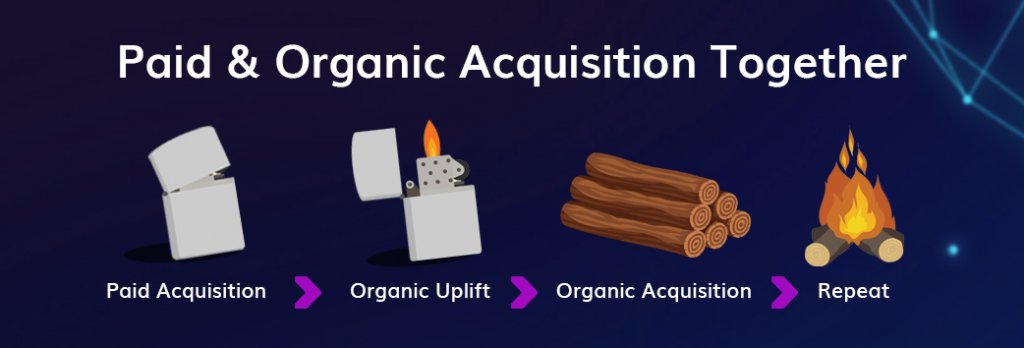
Use automation whenever possible
Automation has been a game-changer for the marketing industry – allowing companies and individuals to do much more with much less time and manpower. If you’re not using automation in your everyday marketing, then you’re playing a losing game with your competitors – as you will never get as good of a return on investment (ROI) or return on ad spend (ROAS) that they do.
Many ad bids are now automated by default. All you need to do is plug in your parameters (target audience, date range, geos, budget, etc.), set the maximum price you’ll accept for ad space, and let the platform do the rest of the work.
Outside of ad bidding though, automation is also very useful for A/B testing in app store optimization (ASO), creating and testing different creative elements, iterating quickly on designs and marketing campaigns, managing social media, and much more. Make sure to take advantage of a variety of different automation tools.
- Tools for the job: Upptic provides automated app store optimization (ASO) testing. Braze and other CRMS offer automation. Many MMPs include automation as well.
Focus on making great creatives
Great creatives help attract high-quality users who won’t churn. It’s important to use a variety of creatives for your paid and organic campaigns – keeping in mind that some platforms cater to different ad formats. It’s also important to A/B test your creatives and continue optimizing them with automation and data-driven insights.
Here is a look at several of the most popular creative formats.
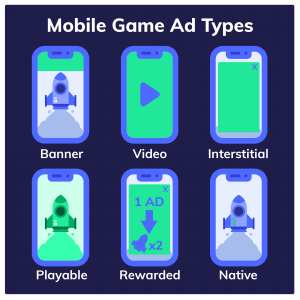
Banners ads
A banner ad is the simplest form of mobile game advertising. Inside a game, they are typically small rectangular ads that are displayed at the top or bottom of the screen. Banner ads can be static or animated and are usually less than 30 seconds in length.
Outside of a game they appear mostly in the margins of websites. Due to ad blindness, also known as banner noise, these are among the least effective types of ads. However, they still have some utility in user acquisition especially because they are generally low cost compared to other ad types.
Interstitial ads
An interstitial ad is a full-screen ad that is displayed between game levels or at other natural breaks in gameplay. They are typically 15-30 seconds in length and can be either skippable or non-skippable. These can be very effective because the advertiser has a captive audience and is able to weave a short narrative while they have the users attention.
Playable ads
Playable ads allow users to play a simplified game experience before downloading it. These ads are very effective because they make the advertising experience more dynamic than ever before. Instead of a video or static advertisement that can be buried, ignored, or overlooked, playable ads allow users to try before they buy. This is more effective for advertisers, as more downloads come from players that have already tried the game before.
Rewarded ads
Rewarded ads are, quite simply, ads that users are rewarded for viewing. Most commonly these come in the form of rewarded video ads that players can watch in exchange for in-game currency or useful in-game items.
Incentivized ads
Incentivized ads are ads that reward players in one game for completing objectives in another game. For instance, an ad in Game 1 might tell a user to finish Quest X in Game 2 in order to receive 200 gold coins in Game 1. As you can see, while rewarded ads reward players for simply viewing an ad, incentivized ads actually move the player into the other game to complete an action and receive their reward – increasing the likelihood of conversion.
Native ads
A native ad, ideally, doesn’t really look like an ad at all. It’s embedded so cohesively with the surrounding game environment that it just seems like part of the game. Examples are a billboard for an actual product in the downtown area of a game or a radio spot that comes on while driving in a car simulator game.
Search ads
Search ads are ads that show up in search engine results. These are best equipped with high-volume, low-competition keywords that are relevant to your game or audience. Understanding your user is exceptionally useful when working with search ads. Search ads are typically text-only and must direct to a website page or, if in an app store, an app product page.
Video ads and posts
Video ads are typically 15-30 seconds in length and can be either skippable or non-skippable. Within a game, skippable video ads give players the option to skip the ad after a few seconds, while non-skippable video ads must be watched to completion. Often a video ad can also be combined with game mechanics to act as a rewarded video ad.
On a social media platform, video ads and organic video posts are typically much more engaging and effective vs. static ads and posts. Like with in-game video ads, it’s best to keep social media video creatives to 15-30 seconds. It’s also highly recommended that all video creatives come with subtitles, as many people, especially on social media platforms, have sound off by default.
Static ads and posts
Static creatives are still pictures – sometimes combined with captions or written posts. Like banner ads, these are less effective due to the fact they don’t catch people’s attention as much as more eye-catching creatives like video. However, they can still be quite useful – especially on social media. Using memes and other static imagery can be a great way to engage with your audience.
- Tools for the job: Upptic provides creative production services for video ads, game trailers, and more. AdMob and Ironsource cater to rewarded video ads. Playin offers a creator for building playable ads.
- Check out our complete guide to mobile game ad revenue.
Cross-promote your mobile game
Cross-promotion in mobile game advertising refers to the act of placing ads or other promotion for one of your mobile games into another one of your mobile games. This is a good idea for a few reasons:
1) Active players of one game will be familiar with and appreciate your quality of work and, therefore, be more inclined to try another game of yours. 2) Assuming both games are on the same platform, conversion is more likely. 3) Assuming both games are the same genre, conversion is more likely. 4) It’s essentially free advertising.
So, especially, if you have multiple games of the same genre and on the same platform, it’s definitely recommended that you cross-promote them.
- Tools for the job: Service providers like Ironsource and Adikteev offer in-app cross-promotion tools for app developers.
Multi-platform and cross-platform games
Multi-platform games are simply games that are released on multiple platforms. The benefits of a multi-platform game are, first and foremost, the ability to capture players outside of a single gaming ecosystem. That said, in many cases, making a multi-platform game also means a longer development period and additional resource allocation for maintenance.
Cross-platform gaming takes this a step further by allowing people on one platform, like Playstation, to play the same game with people on another platform, like Android. One of the most well-known examples of a cross-platform game is Fortnite. Additionally, some cross-platform games allow players to switch between devices without losing their in-game progress (though they usually have to purchase the game for each platform they play it on). This is sometimes known as cross-progression.
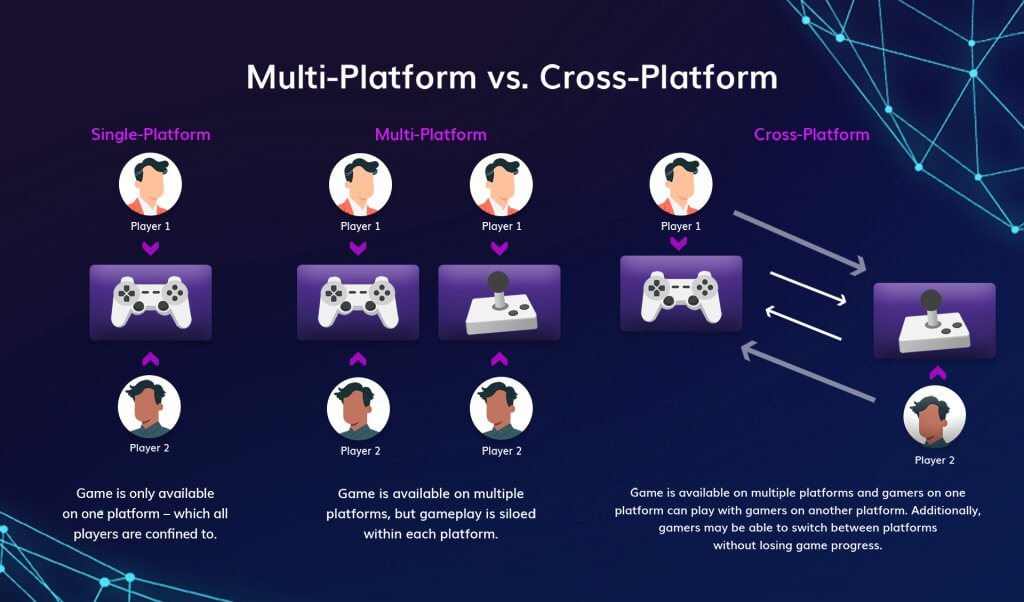
Cross-platform games often require even more development and maintenance than multi-platform games, as well as the proper infrastructure, so making one should not be considered lightly. However, as more and more people game on multiple platforms, it can definitely provide a competitive advantage.
Ultimately, you need to balance the resources required to create and maintain your game app across these different ecosystems with the return you get on doing so. That said, it’s not uncommon to find many apps and games available in at least both Apple iOS’s App Store and Android’s Google Play.
And since Apple is much more stringent about which apps are allowed in the App Store, it’s practically a given that if your app is approved there it will also be approved for Google Play. On the other hand, if you’re thinking of expanding your Google Play app to Apple’s App Store, you will want to make sure you have all your bases covered before proceeding.
- Tools for the job: Unreal Engine and Unity are a couple of the top game development tools – and many plugins are available for cross-platform development. Both allow you to create games for iOS and Android. If you’re planning to put your game in both the App Store and Google Play, make sure to check out all the requirements and restrictions for each store beforehand.
Take advantage of current trends
The last few years have been full of ups and downs for the mobile marketing and gaming industries. Here is a look at a couple of the top trends and how to alleviate the pressures associated with them
Privacy concerns
Mobile marketing is built on data. Over the last decade, the industry has built efficient and holistic pipelines for capturing data, analyzing that data, and making data-driven decisions. Then, in 2021, Apple released its App Tracking Transparency (ATT) framework with iOS 14.5 – effectively gutting the ecosystem the industry had built.
ATT effectively cut marketers and developers off from important data about their ad viewers and app purchasers – not only making segmentation and targeting more difficult, but also making ad attribution more difficult. Apple created SKAdNetwork as a solution, but marketers throughout the industry have found it less than adequate compared to what they previously had.
While Apple created its App Tracking Transparency framework amid consumer and government concerns regarding data privacy, there’s no doubt that Apple has benefited from the chaos. Indeed, more marketers are turning to first-party solutions like Apple Search Ads to fill in gaps they now have with third-party data and solutions.
Similarly, Google is also on the road to limiting the data that marketers and developers receive – both on the Android platform and across the web – with the company planning to phase out third-party cookies on its Chrome web browser by 2024.
While the last few years have been tumultuous, and the next few years look to be equally tumultuous, there are some solutions to help mitigate the issues these changes have caused.
Solution: Use shorter predictions and payback windows
A lack of data makes predictions more, well, unpredictable. In order to compensate for the lack of data in projections, keep your projection periods short and, additionally, stick to shorter payback windows.
Extending your payback windows may justify your ad spend, but it ultimately hurts your marketing long-term. If you aren’t seeing the results you need with tighter payback windows, you should iterate and innovate on your user acquisition campaigns – not get fuzzy with the numbers.
Solution: Use mixed media modeling
With tighter returns on ad spend (ROAS), it’s important to spend every marketing dollar effectively. With a drop in traditional measurement capability, companies will need to seek alternative ways of measuring ad effectiveness. One way to do this is with mixed media modeling.
This approach uses multiple data sources to track how different channels contribute to a sale. By using this method, companies will be able to attribute sales to specific marketing channels and better understand where to focus their marketing resources.
- Tools for the job: Agencies like Upptic can use a mixed media modeling approach for your user acquisition campaigns and guide you in the process of mixed media modeling.
Solution: Innovate with communities
One potential workaround to issues with ad attribution is to forgo ads in favor of partnering directly with online communities where your target audience congregates. Getting in touch with the community leaders and offering to do Q&As and AMAs in their space, as well as provide discount codes and other perks to community members, is a great way to not only raise brand awareness, but connect with your audience on a deeper level.
Solution: Build out your data infrastructure
First-party data will become more valuable as stricter privacy policies are put in place. Companies that are able to collect user data will have a competitive advantage over those that do not. Because of this, companies should consider building out infrastructure for collecting first-party data and teams for analyzing and acting on this data.
Additionally, take advantage of Apple’s data collection opt-in screen on the App Store. Make sure to provide app installers with a compelling reason to opt-in to data collection – whether that’s a better user experience, targeted ads, or something else.
Pandemic highs and economic lows
The pandemic has largely been good to the mobile games industry, but as life returns to pre-pandemic norms amid a fluctuating economy, things have definitely taken a downward turn. In 2022, for the first time ever, the mobile games industry saw a decline in revenue. While the outlook still looks rosy overall for mobile gaming, now is a good time to take stock of things.
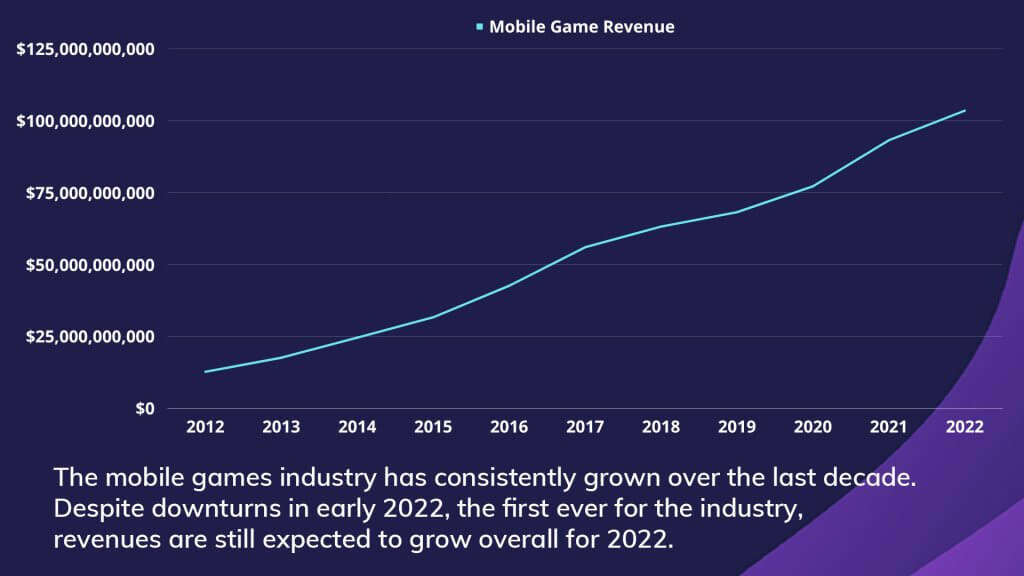
Solution: Pull back on spending and evaluate channels
One of the first things to do amid all the chaos in the economy is to pull back on spending and evaluate the performance of your channels to make sure you’re focusing on the ones that are most effective. Once you’ve done a channel audit and dropped the ones that aren’t achieving top performance, you can begin injecting money back into paid and organic initiatives.
Solution: Focus on niches
As more mobile games enter the market even as players exit it in increasing numbers, it’s more important than ever to find niches with less competition and own them. Do your due diligence in deciding what genre your next game will be and what audience you want to target. Look around for underserved demographics and provide them with a stellar experience so you can own that segment.
Analyze and optimize with a marketing stack
It’s been said repeatedly throughout this article, but can’t be understated: You need to continually analyze what you’re doing and optimize performance in order to succeed in the mobile games industry. If you don’t have a data scientist on your team, invest in one. Data analysis is full-time work, but the reward from being able to make data-driven decisions speaks for itself.
Building a marketing stack
In order for anyone to do effective data analysis, they need a great marketing stack. Every marketer will use different tools to get the job done, but every marketing stack should have the following components.
Mobile measurement partner
A mobile measurement partner (MMP) is a company that provides attribution for marketing campaigns. They collect and organize the raw data from your marketing campaigns so you can better understand their performance.
- Tools for the job: AppsFlyer, Adjust, and Singular are among the most popular MMPs. Upptic, while not an MMP, does have robust tools for data and performance analysis.
Marketing data warehouse
A marketing data warehouse consolidates all your data – whether it be from ad platforms, your website, your CRM, or other marketing tools – in a single place. This is important for seeing every customer’s journey through your company’s funnel and touchpoints, from first contact to playing your game. This information can help you understand pain points and provide a better experience for prospective and current players.
- Tools for the job: Google, Amazon, and Microsoft all offer data warehouse solutions. Additionally, companies like Supermetrics can help you create a cohesive pipeline from your different data sources into your data warehouse.
Visualization tools
Visualization tools allow you to digest all the data you have access to. Looking at raw data is massively difficult and overwhelming, but data visualization makes it easy for a data scientist to identify trends and turbulence in your marketing initiatives.
- Tools for the job: Upptic has out-of-the-box views for marketing performance. Platforms like Tableau, Google Data Studio, and Observable offer data visualization services. Additionally, many MMPs come with data visualization tools.
Workflow management tools
A workflow manager allows you and your team to keep on top of all the marketing initiatives. Between paid advertising, evergreen content, data analysis, and creative development – workflow management tools are essential for ensuring work isn’t forgotten and gets completed on time.
- Tools for the job: Workzone and Workamajig offer project management tools aimed at marketing. Wrike, Trello, and Asana provide general workflow management solutions.
Workflow automation tools
Workflow automation tools make it easier for you and your team to stay on top of work and smoothly transition from one phase of work to another. These can take some time to prepare, and require established pipelines so you can organize inputs and outputs, but are well worth the setup required.
- Tools for the job: Zapier allows you to integrate different tools with each other and set up triggers for automated actions. CRM tools like HubSpot and Salesforce Marketing offer automation within their ecosystems. And management tools like Trello and Asana provide some automation as well.
Beware of mobile ad fraud
Mobile ad fraud is the bane of marketers everywhere. In the most simple terms, mobile ad fraud is the act of using mobile ad tech to defraud advertisers, game publishers, or supply partners. Mobile ad fraud comes in three forms: app install farms (also known as SDK spoofing), click spam and ad stacking, and click injection fraud.
In 2018, fraudulent web traffic made up over a quarter of industry ad spend – roughly $66B. It’s expected that ad fraud will cost the industry $81B for 2022. Additionally, it’s estimated that 31% of iOS app installs and 25% of Android app installs are fraudulent.
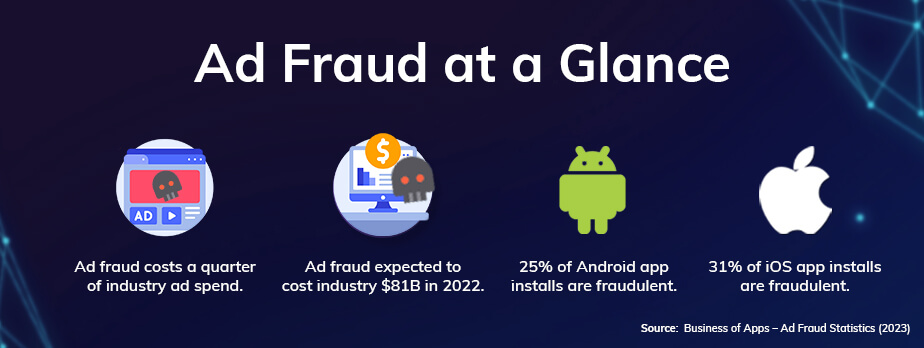
How to avoid ad fraud
As you can see from these statistics, mobile ad fraud is a major source of lost revenue and ad-spend for the industry. So what can be done about it?
The #1 thing you can do is to carefully examine your attribution data and make sure none of your data exists in a silo – this includes having access to as much data as you can get from marketing partners. Pooling all your data together makes it easier to find inconsistencies and irregularities (such as repeated IP addresses for conversions). Having a team member devoted to detecting ad fraud is one of the best ways to make sure no ad fraud slips through the cracks.
Additionally, many MMPs and ad platforms offer ad fraud prevention tools that can help with your own ad fraud prevention efforts.
- Tools for the job: MMPs like Adjust and AppsFlyer have tools to aid in ad fraud prevention. Make sure they’re a part of your marketing stack.
Key takeaways
As you can see, there is a lot of work and attention to detail that goes into mobile games user acquisition. If you forget everything else that you’ve read today, the most important things to remember are that data and data-analysis are king, iteration and optimization is imperative, and engaging with your audience in creative ways is key.

